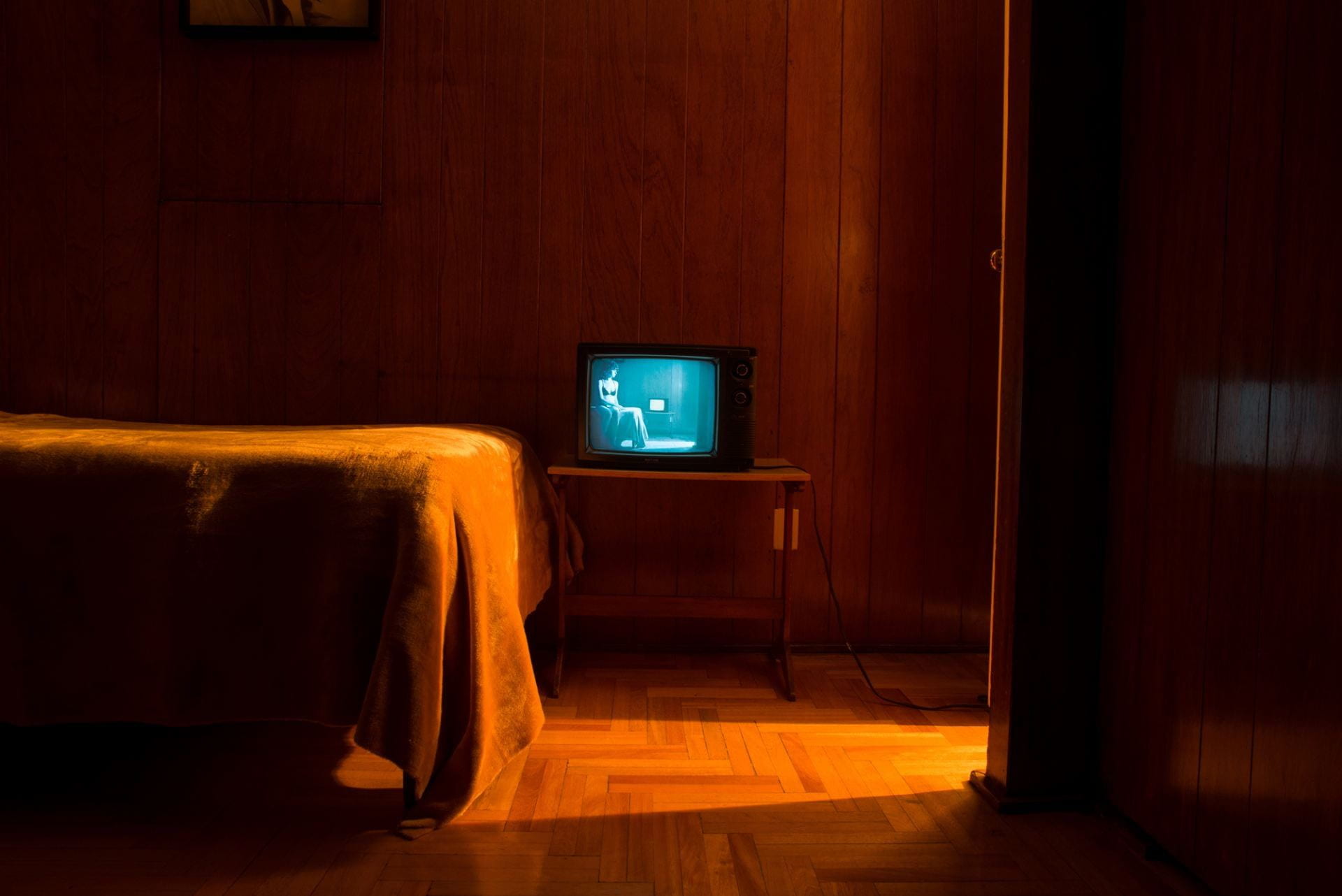In The Republic, Plato recounts a dialogue between Socrates and Glaucon about whether or not art should be banned, since it is a mere imitation of things that takes people further and further away from truth. They conclude that art is an unreliable source. I was reminded of this argument when I first encountered Tania Franco Klein‘s 2016 Contained (Self-Portrait), found in her photo book Positive Disintegration. The picture of an unoccupied hotel room features a small television at its center. The same room, from the same angle, is reproduced on the black and white TV screen, this time inhabited by a woman, who, remembering the parenthetical in the title, we assume is the photographer.
The photograph goes on forever, since inside the first television there is a second one, but the image on that screen isn’t easily perceived, thus creating a sense of infinity and suspense. Franco Klein’s Positive Disintegration project explores emotions (mostly negative) that surface as a consequence of the generational drive for success and happiness. It represents the pressure of achieving and portraying a perfect lifestyle, in spite of what is lost or neglected in trying to do so.
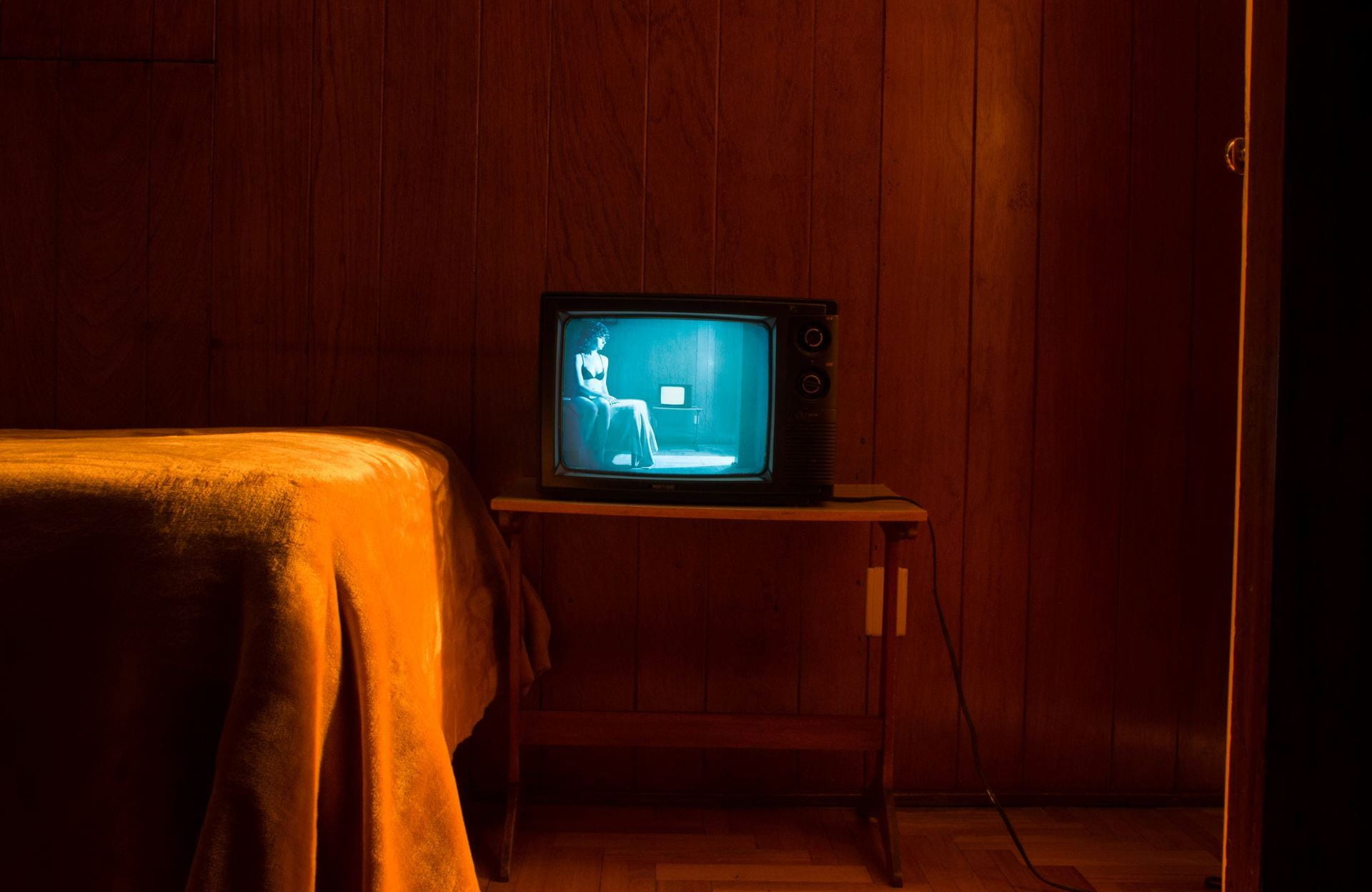
Detail from Tania Franco Klein, Contained (Self-portrait), 2016
© Tania Franco Klein, courtesy the artist and ROSEGALLERY, Santa Monica
Plato would say The Form of the woman, the television, and the bed would be closest to the truth. But we cannot access them through our senses. Following his theory, The Forms are divine and eternal, they are an unchanging reality that exists outside of our material world. Everything we might access through our senses derives its identity from The Forms, so it’s all an imitation of the truth, never The Forms themselves. Actual things (and beings) are categorized by Plato as “perceptual” objects, since we recognize them through our senses. Those objects, therefore, are imitations of true forms. And if you’ve followed me so far you might guess that Franco-Klein’s photograph itself is an imitation of an imitation of truth, making the image inside the television a complete abomination to our ancient philosopher.
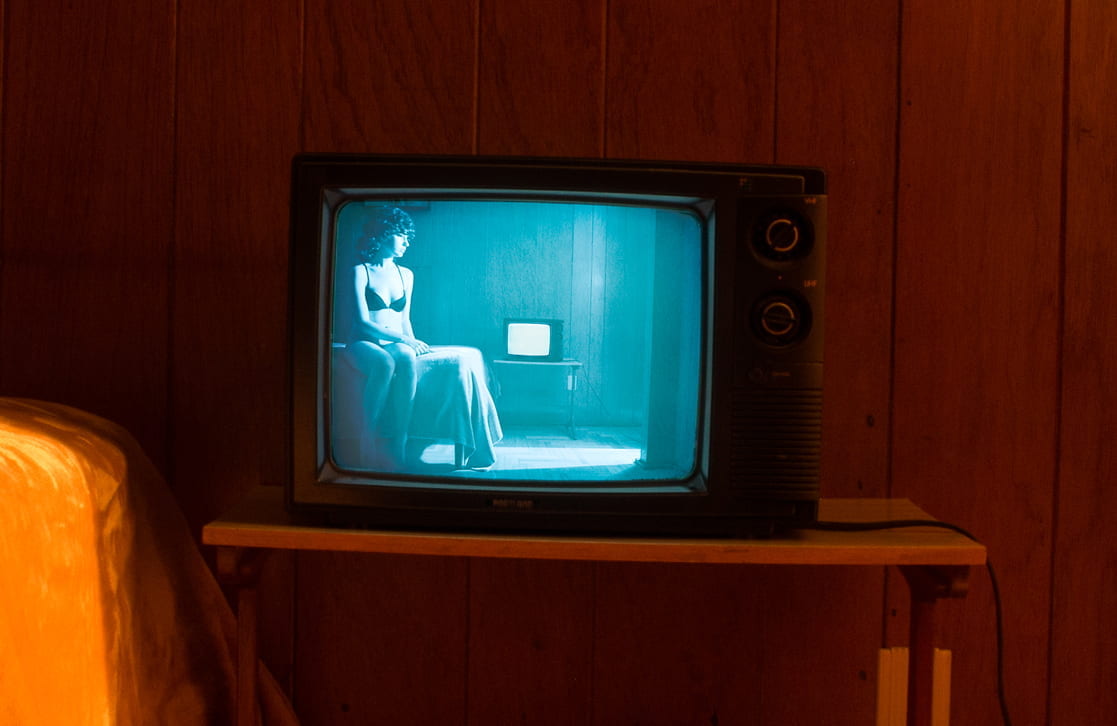
Detail from Tania Franco Klein, Contained (Self-portrait), 2016
© Tania Franco Klein, courtesy the artist and ROSEGALLERY, Santa Monica
Can the photograph be called a self-portrait? Or is the woman contained in the television too far away from who Tania Franco Klein really is? Honoring the sense of curiosity the photograph caused in me the first time I encountered it at Pier 24 in San Francisco, I will tell you what I know about the photographer and muse of this piece. Tania Franco Klein is a 32-year-old Mexican artist. At her young age she has earned a bachelor’s degree in architecture and a master’s degree in photography. She has been published in The New Yorker and Aperture and has won several international photography awards.
Franco Klein revealed the inspiration behind Positive Disintegration in a 2018 interview by Jim Casper for Lens Culture. “One day I was in a bookshop in Madrid, and I saw a title in the philosophy section called The Burnout Society by Byung-Chul Han. The title struck me. I was like, this is exactly how I feel.” In that book, the Korean-born German author and philosopher argues that there is a generalized inability to face negative experiences in a time when everything has to be perfect and everyone is supposed to be happy. He claims that stress, anxiety, depression and exhaustion have become social and historical phenomena that are affecting an entire generation. That is how the photographer felt when she came across The Burnout Society in a period of her life when she was lonely and isolated. So she did what artists do best, she channeled all these feelings into her art.
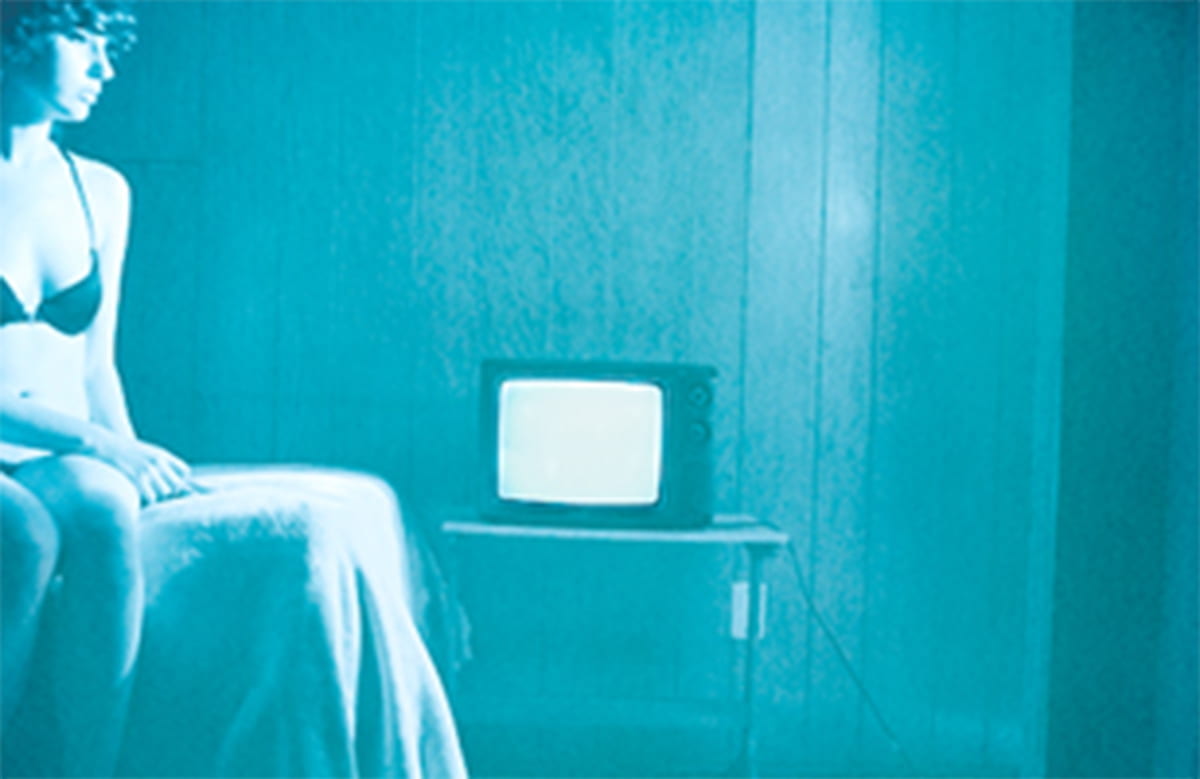
Detail from Tania Franco Klein, Contained (Self-portrait), 2016
© Tania Franco Klein, courtesy the artist and ROSEGALLERY, Santa Monica
Franco Klein wanted to transform these feelings of loneliness, solitude, and anxiety while taking the autobiography to a more generational and universal scale. As she states in the interview, her main character is not herself, but emotion. She is not trying to simply capture a picture of a woman on a television screen in a hotel room, but to take the emotion of solitude and depression and make it into art. So then, Plato’s desire to ban art takes a new turn. What if these emotions, which are part of the realm of ideas and knowledge, don’t have a perceptual shape in our world and Franco Klein is giving it to them? Will art still be an imitation of life? Or is life imitating art? As Oscar Wilde wrote in his essay The Decay of Lying (1889), “Life imitates art far more than art imitates life,” adding further, “the self-conscious aim of life is to find expression, and art offers it certain beautiful forms through which it may release that energy.” Through her art, Franco Klein is shaping emotions and giving them a place in the world.
The woman in the Franco Klein photograph IS loneliness, depression, isolation, and exhaustion. All of these emotions are contained, in a mise-en-abyme, a picture within a picture that draws you in and shamelessly undresses your emotions, making them its own.
I hadn’t felt so connected to an art piece in a very long time. As an exchange student, spending a semester in San Francisco, away from my home in Colombia I felt very understood and mirrored in the photograph. Doing an exchange semester can be very enriching, but, feelings of loneliness and alienation remain. All my relationships with loved ones back home are conducted through a screen. And if I allow myself to be egocentric, I am also contained in a screen for my loved ones, just like Franco Klein’s “self-portait.” Can they really grasp the woman I am becoming? Is there a way of expressing love that is strong enough to transcend distance and the limitations of electronic communications? There must be, because love and art always find their way into the world and into others.
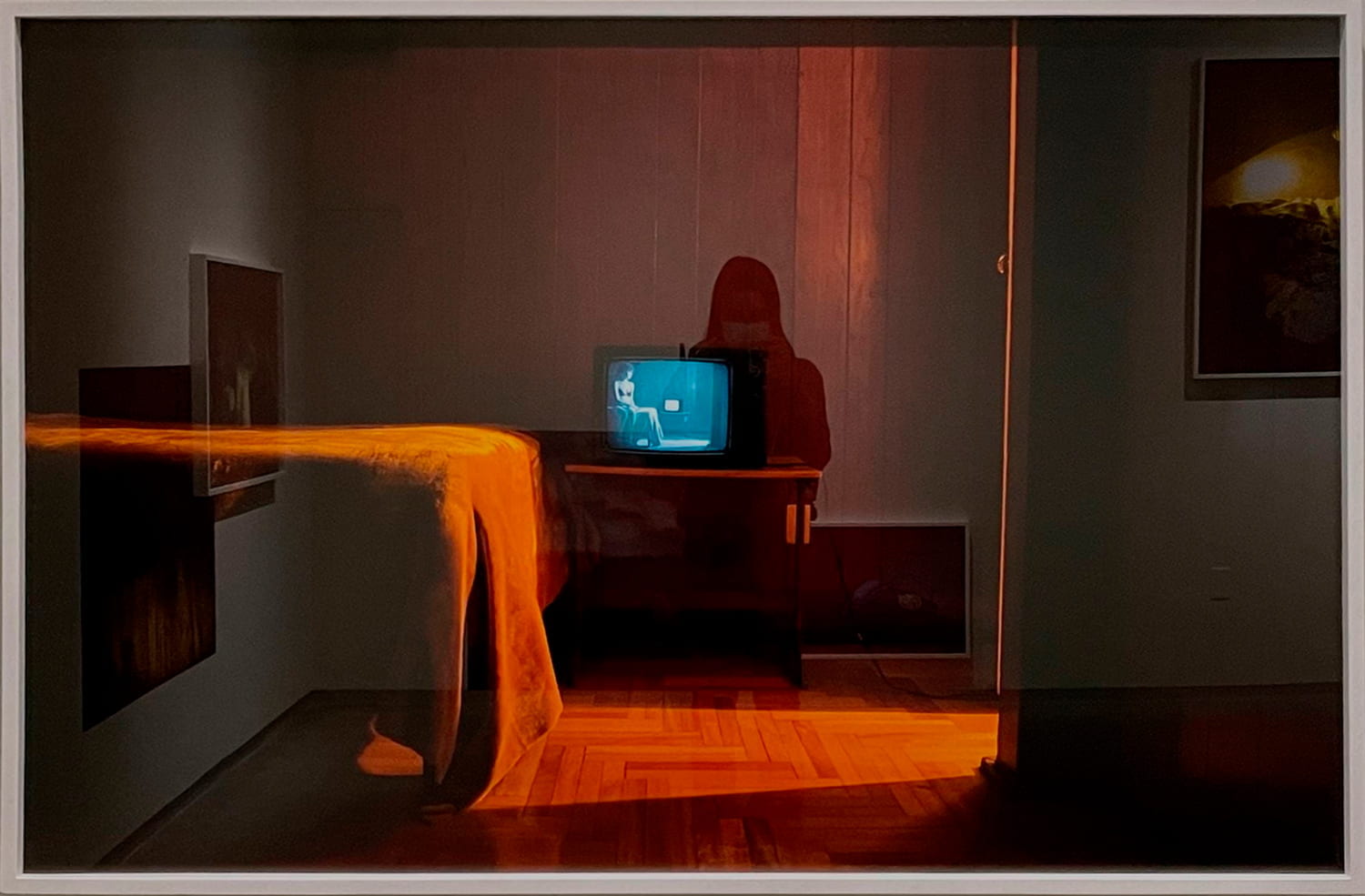
The author Laura Carcache Guas reflected in the glass covering Tania Franco Klein’s 2016 Contained (Self-Portrait) at Pier 24 in San Francisco.
Post produced for Multimedia Storytelling course Fall 2022.
ABOUT THE AUTHOR:
 Laura Carcache Guas is a Colombo-Cuban communication student, filmmaker, and philosophy enthusiast. Laura spent an exchange semester at the University of San Francisco during fall of 2022. She is currently studying in Cali, Colombia.
Laura Carcache Guas is a Colombo-Cuban communication student, filmmaker, and philosophy enthusiast. Laura spent an exchange semester at the University of San Francisco during fall of 2022. She is currently studying in Cali, Colombia.
